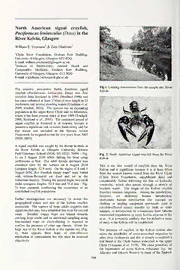
North American signal crayfish Pacifastacus leniusculus (Dana) in the River Kelvin, Glasgow PDF
Preview North American signal crayfish Pacifastacus leniusculus (Dana) in the River Kelvin, Glasgow
North American signal crayfish, Pacifastacus leniusculus (Dana) in the River Kelvin, Glasgow & William E. Yeomans' Zara Gladman^ 'Clyde River Foundation, Graham Kerr Building, University ofGlasgow, GlasgowG12 8QQ. E-mail: [email protected] ^Institute of Biodiversity, Animal Health and Comparative Medicine, Graham Kerr Building, UniversityofGlasgow, Glasgow, G12 8QQ E-mail: z.gladman. ©research.gla.ac.uk 1 Fig.l. Lookingdownstream from the sample site, River The invasive, non-native North American signal Kelvin crayfish {Pacifastacus leniusculus Dana) was first recorded from Scotland in 1995 (Maitland 1996) and has since colonised at least 174km ofriver length in 13 catchments and several standing waters (Gladman etal. 2009; Sinclair, 2010). The species has an expanding population in the upper River Clyde and its tributaries, where it has been present since at least 1989 (Trudgill, 2000; Maitland et al, 2001). The continued spread of signal crayfish in Scotland is of concern because it presents a significant risk to native biodiversity and for that reason was included in the Species Action Framework fortargeted action for five years from 2007 (SNH, 2007). A signal crayfish was caught by Mr David Scobbie in the River Kelvin at Glasgow University Science ParkWeterinary School (NGR: NS 55321 70494 - Fig. Fig. 2. North American signal crayfish from the River 1) on 3 August 2010 while fishing for trout using Kelvin earthworms as bait. The adult female specimen was examined alive by the authors on 4 August 2010 This is the first record of crayfish from the River (carapace length: 52.9 mm). On the nights of4 and 5 Kelvin and is significant because it is at least 65km August 2010, five Swedish trappy traps* were baited from the nearest known record from the River Clyde with salmon-flavoured cat food and set in the (Clyde River Foundation, unpublished data) and immediate locality. During the second night, two adult considerably further following the line of hydraulic males (carapace lengths: 53.8 mm and 55.4 mm - Fig. continuity, which also passes through a stretch of 2) were captured, confirming the occurrence of an brackish water. The origin of the Kelvin crayfish established crayfish population. therefore remains enigmatic. Among the possibilities, however, are deliberate human introduction; Further investigations are necessary to assess the inadvertent human introduction (for example on geographical extent and size of the Kelvin crayfish clothing or angling equipment previously used in population. The capture of large adults suggests that crayfish-affected areas); transfer by birds or other signal crayfish may have inhabited this river for several animals; or introduction by colonisation from hitherto years. Swedish trappy traps are biased towards unrecorded populations in water bodies adjacent to the catching large adults and so additional sampling using river. It is extremely unlikely that the definitive route fine-meshed traps or electrofishing is required to ofentryto the Kelvin willbe established. confirm the presence of other age classes. Given the large size ofthe River Kelvin at the capture site (Fig. The presence of crayfish in the Kelvin system also 1), there appears little hope of cost-effective raises the possibility of cross-watershed migration to eradication or containment but this must be assessed other river catchments and this is already considered a objectively. real threat at the Clyde-Annan watershed in the upper Clyde (Yeomans et al. 2010). The close proximity of the headwaters of some Kelvin tributaries (eg. the Allander and Glazert Waters) to those of the Endrick 104 system (Loch Lomond catchment) mean that vigilance is required to protect the natural heritage of Loch Lomond and its rivers from the ingress of North American signal crayfish. We thank David Scobbie for access to the first specimen and the committee and members ofthe River Kelvin Angling Association for their support. The three specimens referred to in this note have been deposited in the Hunterian Museum Zoology Section, Lfniversity of Glasgow [Voucher Numbers 140 273 (female) and 140274 (males)]. *Trapping was conducted under licence from the Scottish Government. It is illegal to trap, be in possession ofortransport live signal crayfish without a licence. REFERENCES Gladman, Z., Adams, C.A., Bean, C., Sinclair, C. and Yeomans, W.E. (2009). Signal crayfish in Scotland. P43-48 In: Brickland, J., Holdich, D.M. & Imhoff, E. (editors). Crayfish Conservation in the British Isles; Proceedings ofa conference held on 25^^March2009 inLeeds, UK. Maitland, P.S. (1996). The North American signal crayfish, Pacifastacus leniusculus (Dana), established in the wild in Scotland. Aquatic Conservation: Marine andFreshwater Ecosystems 107G10. 6, Maitland, P.S., Sinclair, C. and Doughty, C.R. (2001). The status of freshwater crayfish in the year 2000. GlasgowNaturalist, 23, 26-32. ScottishNatural Heritage (2007). A Five Year Species Action Framework: Making a Difference for Scotland’s Species (http://www.snh.gov.uk/protecting-scotlands- nature/species-action-framework/). Sinclair, C.A. (2009). Fine-scale mapping of signal crayfish distribution in Scotland. Report to Scottish Natural Heritage (ProjectNo. 26686), 62pp. Trudgill, N. (2000). North American signal crayfish {Pacifastacus leniusculus) in the River Clyde. The United Clyde Angling Protective Association Ltd. Wishaw, UK, 12pp. Yeomans, W.E., McColl, D. and Law A. (2010). Clydes Bum Crayfish Survey. Clyde River Foundation Report2010/01, Glasgow, 17pp. 105
